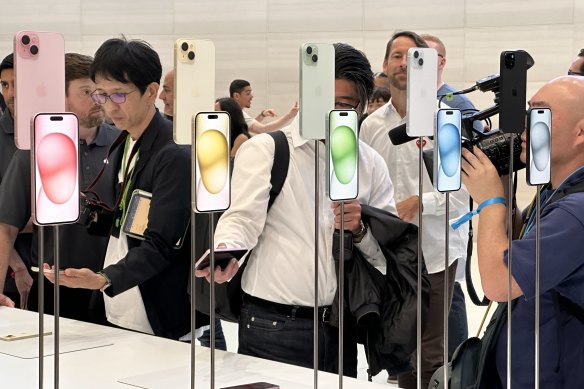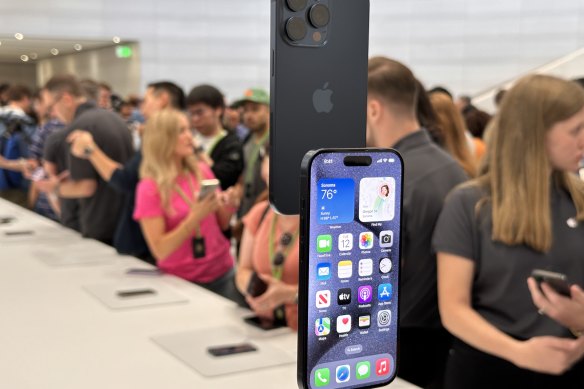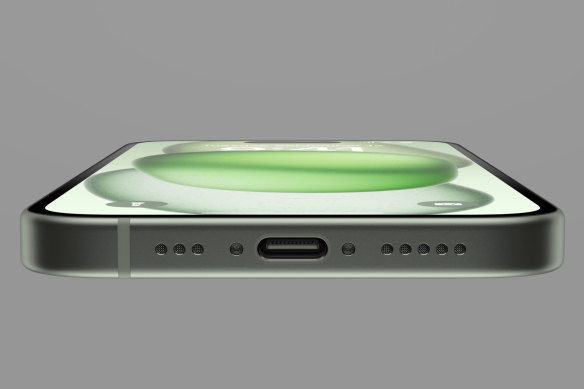
Save articles for later
Add articles to your saved list and come back to them any time.
Apple’s latest smartphones, announced Wednesday morning in California, have a slew of new features packed in. Which also means they raise a slew of new questions, not all of which were answered satisfactorily in its brief livestream.
The company has finally outfitted its phones with USB-C, after something of a nudge from European lawmakers, and it’s brought some (but not all) of its best features from last year’s Pro phones to the standard model. For this year’s iPhone Pro, Apple has dropped the long-lived mute switch and claims the phone has access to seven camera lenses despite there only being three physically present. Here’s how it all works.
The iPhone 15 sticks with bright colours, though it has a very different finish this time.Credit: Tim Biggs
New port, new cables
Apple resisted giving USB-C a funny marketing name as it has for other industry standards, which is understandable as it’s already a very common technology found on everything from headphones to monitors to cameras. So, will all that stuff work with your USB-C iPhone when you plug it in? Yes, but with some caveats.
The standard iPhone 15 models have USB-C but at the older USB 2 specification, meaning their maximum data transfer speed is the same as last year’s iPhone 14 despite the new connector, at 480 Mb per second. Anything that requires USB 3 speeds (up to 10Gb per second) will not work. However the new spec does mean the iPhone can put out enough juice to charge your AirPods or Apple Watch if you connect them with a cable.
When it comes to the iPhone 15 Pro, there is support for USB 3. Apple said the reason it’s included here and not on the standard model is because the USB 3 controller is built into the new A17 Pro chip, whereas the standard model has last year’s A16 Bionic. All versions of the phone appear to come with the same braided USB-C cable, which is colour-matched to your iPhone and looks really nice, but itself is only capable of USB 2 speeds. You will need a different cable and a fast charging power adapter to maximise everything, though because it’s USB-C you may already own some.
The action button on the iPhone 15 Pro can open the camera, or even set off smart home devices.Credit: Tim Biggs
The Pro difference
Aside from the USB-C spec, the new phones differ in a number of ways. The iPhone 15 and 15 Plus borrow a lot more from last year’s 14 Pro than its processor, including its matte glass finish, thinner screen bezels and the dynamic island that serves as a home for notifications and other data. But the always-on display and fast refresh rates remain a Pro-exclusive feature.
The new Pros have titanium cases for the first time and sport a brushed metal look in typically muted Pro colours. The screen borders have shrunk even farther so that the phones are physically smaller than their non-Pro counterparts, and when you pick them up the first thing you notice is that they’re extremely light compared to last year’s steel Pros.
On the side the Pros have a new button where the mute switch used to be, and you can choose what it does in the phone’s settings. It can mute and unmute your phone of course, or open the camera to a specific mode (and act as the shutter button), activate any Siri shortcut, start a voice recording and more. It has tactile feedback a bit like the Apple Watch’s digital crown, so you can feel that it did something even if you’re pressing it without looking.
The iPhone 15, now with the same connector as your other devices.
How many lenses?
Apple says that the iPhone 15 is like having three cameras in your pocket, even though the main lens array still only has two. What it’s referring to is that the wide lens now has a 48MP sensor, which is big enough that you can crop a full picture out of the middle, in effect giving you a high quality 2x zoom. I’ll grant that that might be “like” having three cameras, but we’ll need to test a bit more extensively to see how it holds up.
Things get a bit silly on the Pro with the claim that it has seven lenses, although seeing the system in action is impressive. Essentially, the camera app gives you a number of different focal length options for each of the three main cameras, and toggling between them is roughly equivalent to changing lenses on a traditional camera. You can also individually set your favourite so it always switches to that when you use that lens.
The Pro Max has an exclusive trick of its own here; a 5x optical zoom lens in place of the smaller Pro’s 3x. This is not a periscope lens as had been rumoured, but a new design that Apple calls a tetraprism. Essentially, it bounces light back and forth to create the effect of a long lens without a massive camera bump. It also comes with a new image stabiliser that moves in all three dimensions, and in my brief hands on I was able to easily focus on faraway faces and lock them.
Yes, they’re more expensive
Most new iPhones are between $70 and $100 more expensive than their equivalent iPhone 14. For starting prices that’s $1500 for the iPhone 15, $1650 for the Plus and $1850 for the Pro. But in the US Apple is keeping the prices the same as last year, which would indicate that our local price rise is more to do with currency fluctuations than anything else, given the company works out the prices in US dollars first.
One exception to all this is the $2200 iPhone Pro Max, which has seen an increase to its starting price even in the US. But this is because the least expensive model has 256GB of storage, whereas last year you could choose a 128GB model.
As with every year, it’s worth your while now to look at what the release of the new iPhone has done to previous models’ prices. The iPhone 13 has gone down to $1100, the iPhone 14 to $1300 and the 14 Plus to $1500.
The author travelled to California as a guest of Apple.
Get news and reviews on technology, gadgets and gaming in our Technology newsletter every Friday. Sign up here.
Most Viewed in Technology
From our partners
Source: Read Full Article


